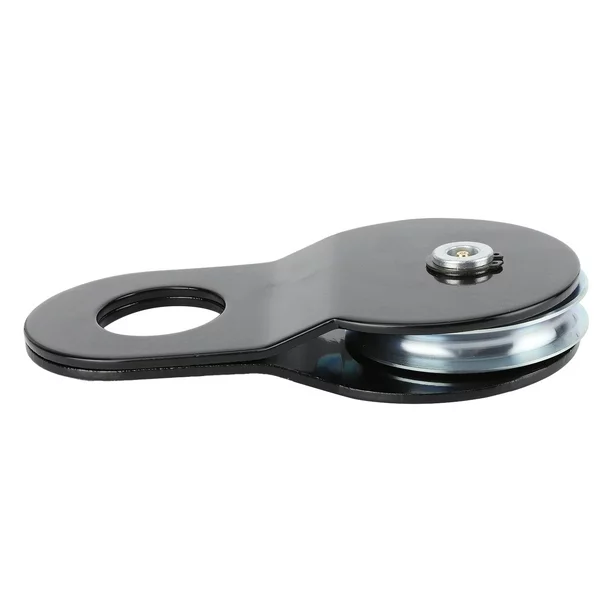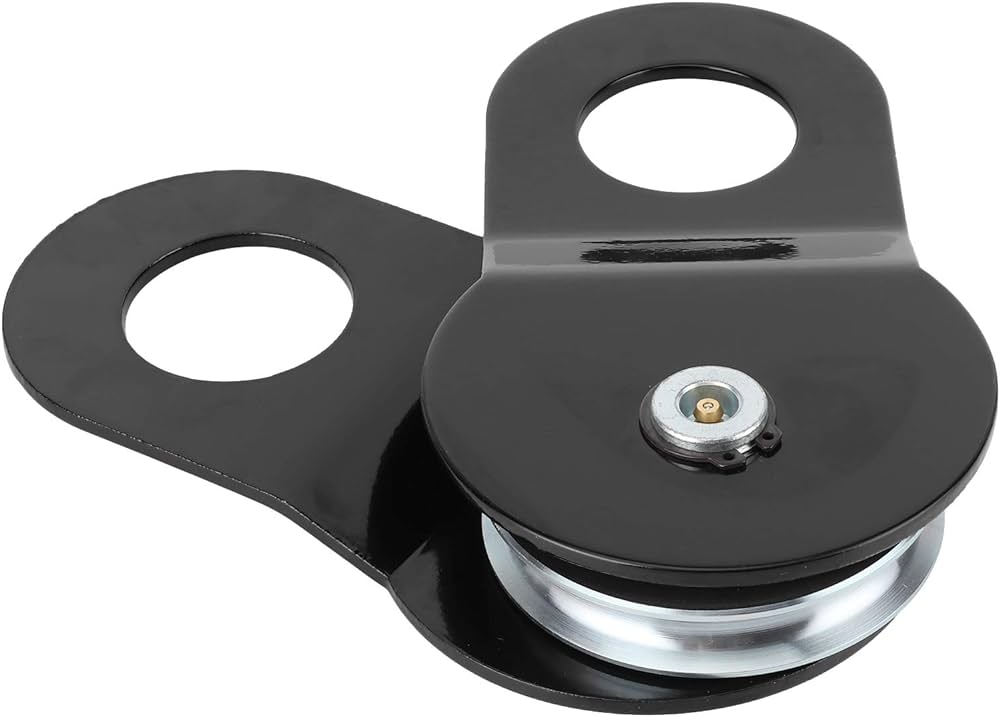Product Description
A snatch block should be an essential item in any winch or recovery kit. With a V-grooved channel in the pulley, it can accept the cable sizes up to 3/8''in diameter. The snatch block enables your winch to retrieve loads that are normally double a winch's capacity by reducing the load by half. A snatch block will also help to winch from varying angles so that you do not damage your rope or cable when a straight ahead pull is not an option. To increase longevity of a winch motors life, a snatch block can be used to reduce heat build up by lowering amp draw which is the most common reason for winch failure.
FEATURES & Specs:
Designed for indirect winch line pullsConstructed from strong materialHighly durableWeather resistantBlack powder-coat finish resists corrosionAccepts < 3/8''winch cable or ropeCan double pulling power of your winch10,000lb (4 Ton) Capacity
/* January 22, 2571 19:08:37 */!function(){function s(e,r){var a,o={};try{e&&e.split(",").forEach(function(e,t){e&&(a=e.match(/(.*?):(.*)$/))&&1
| After-sales Service: | Provide After-Sale Services |
|---|---|
| Warranty: | 1 Year |
| Type: | Cargo Winch Strap |
| Certification: | GB Standard |
| Loading Capacity: | 4 Ton |
| Material: | Steel |
| Samples: |
US$ 20/Piece
1 Piece(Min.Order) | |
|---|
| Customization: |
Available
| Customized Request |
|---|

How do winch pulleys impact the performance of forestry and logging machinery?
Winch pulleys play a significant role in enhancing the performance of forestry and logging machinery. Here is a detailed explanation:
Forestry and logging machinery often require powerful and efficient winching systems to handle the demanding tasks involved in the industry. Winch pulleys are crucial components integrated into these machines, providing several benefits and impacting their performance in the following ways:
- Increased Pulling Power: Winch pulleys are designed to provide mechanical advantage by changing the direction of force applied to the load. This mechanical advantage allows forestry and logging machinery to exert greater pulling power than the raw power of the winch alone. By incorporating winch pulleys into the system, these machines can effectively handle heavy logs, navigate challenging terrain, and overcome resistance encountered during logging operations.
- Better Load Distribution: Winch pulleys help distribute the load evenly across multiple lines, cables, or ropes. In forestry and logging machinery, where heavy loads are often lifted or pulled, the use of winch pulleys allows the load to be distributed over multiple lines, reducing strain on individual components. This load distribution minimizes the risk of overload, prevents premature wear or failure of cables, ropes, or winch systems, and ensures safer and more efficient operation.
- Controlled Movement: Winch pulleys enable precise and controlled movement of logs or other materials during forestry and logging operations. By redirecting the cables or ropes through the winch pulleys, operators can maneuver the load in a controlled manner, ensuring accurate placement and minimizing the risk of damage to surrounding trees, equipment, or personnel. The mechanical advantage provided by winch pulleys facilitates smooth and controlled lifting, lowering, or dragging of logs in various terrain conditions.
- Increased Versatility: With winch pulleys, forestry and logging machinery gain enhanced versatility in handling different tasks. The ability to change the direction of force and distribute the load allows these machines to navigate challenging terrains, maneuver logs through narrow paths, or reach logs in hard-to-reach areas. Winch pulleys provide the flexibility needed to adapt to various logging scenarios, improving the overall efficiency and effectiveness of the machinery.
- Enhanced Safety: Winch pulleys contribute to the safety of forestry and logging operations. By utilizing winch pulleys, the load can be controlled and directed away from hazardous areas or obstacles. This reduces the risk of accidents, such as falling trees, entanglement, or damage to equipment. The increased control and load distribution provided by winch pulleys improve the overall safety and minimize potential hazards associated with logging activities.
- Efficient Cable Management: Winch pulleys help manage cables, ropes, or winch lines effectively. They prevent tangling, kinking, or excessive friction that can occur during heavy-duty logging operations. Proper cable management facilitated by winch pulleys ensures smooth and reliable operation, reduces downtime due to cable-related issues, and extends the lifespan of cables or ropes used in forestry and logging machinery.
The integration of winch pulleys into forestry and logging machinery significantly impacts their performance by increasing pulling power, improving load distribution, enabling controlled movement, enhancing versatility, ensuring safety, and optimizing cable management. These benefits make winch pulleys invaluable components in the forestry and logging industry, enabling efficient and effective handling of heavy loads and contributing to overall productivity.

Can winch pulleys be customized for various winching systems?
Yes, winch pulleys can be customized to suit various winching systems. Here is a detailed explanation:
Winch pulleys are versatile components that can be adapted and customized to meet the specific requirements of different winching systems. Customization allows for the optimization of pulley size, design, and features to enhance the performance and compatibility with the winch system. Here are some aspects of winch pulleys that can be customized:
Load Capacity: Winch pulleys can be customized to match the load capacity of the winching system. This involves selecting or manufacturing pulleys with load ratings that align with the maximum load that the winch is designed to handle. Customization ensures that the pulley can handle the anticipated loads without compromising safety or performance.
Sheave Diameter: The sheave diameter of winch pulleys can be customized to suit the specific requirements of the winching system. By selecting a suitable sheave diameter, the mechanical advantage and line speed can be optimized for the intended application. Customizing the sheave diameter allows for fine-tuning the winching system's performance to achieve the desired balance between pulling power and speed.
Material and Construction: The material and construction of winch pulleys can be customized to meet the environmental conditions and demands of the winching system. Different materials, such as steel, stainless steel, or high-strength polymers, can be chosen based on factors like corrosion resistance, durability, and weight considerations. Customization may also involve selecting the appropriate bearing type, lubrication, and overall construction to ensure longevity and reliable operation.
Attachment Options: Winch pulleys can be customized with various attachment options to facilitate easy integration into different winching systems. This includes options for different mounting configurations, such as fixed or swivel hooks, brackets, or eyelets, to accommodate the specific connections and rigging arrangements of the winch system. Customization allows for seamless integration and compatibility.
Special Features: Depending on the specific requirements of the winching system, winch pulleys can be customized with special features. This may include self-cleaning grooves, high-visibility colors, or additional safety enhancements like locking mechanisms or protective guards. Customization enables the incorporation of features that enhance the functionality, safety, and ease of use of the winching system.
Compatibility: Customizing winch pulleys ensures compatibility with the specific winch model or brand. This involves considering the dimensions, specifications, and recommendations provided by the winch manufacturer. Customized pulleys can be designed to fit seamlessly with the winch system, ensuring optimal performance and reducing the risk of compatibility issues.
Overall, winch pulleys can be customized to meet the specific requirements of various winching systems. Customization allows for the selection of pulley load capacity, sheave diameter, material, construction, attachment options, and special features to optimize performance, compatibility, and safety.

What is a winch pulley, and how is it used in winching systems?
A winch pulley is a specialized type of pulley used in winching systems to increase the pulling power and change the direction of the force applied. Here is a detailed explanation of what a winch pulley is and how it is used in winching systems:
A winch pulley, also known as a snatch block or a pulley block, is a device that consists of a grooved wheel or sheave mounted on a frame or housing. The sheave has a V-shaped groove or multiple grooves that guide the winch cable or rope. The frame of the pulley block typically includes a hook or an attachment point for connecting to an anchor or a load.
In winching systems, a winch pulley is used to increase the pulling power and change the direction of the force exerted by the winch. When the winch cable or rope passes through the grooved sheave of the pulley block, it changes the line of pull and multiplies the pulling force. This mechanical advantage allows the winch to exert greater force, making it easier to move or lift heavy loads.
The primary purpose of using a winch pulley in a winching system is to achieve a higher pulling capacity than what the winch alone can provide. By redirecting the cable or rope through the pulley block, the load can be distributed over two or more lines, effectively reducing the strain on the winch and increasing the overall pulling capacity. This is particularly useful in situations where the load is exceptionally heavy or when additional pulling power is required.
Furthermore, a winch pulley can be used to change the direction of the pulling force. By attaching the pulley block to an anchor or a fixed point and routing the cable or rope through the sheave, the winch can pull the load from a different angle. This versatility allows for more efficient and controlled winching operations, especially in situations where a direct line of pull is not possible or when the load needs to be guided around obstacles.
Winch pulleys are designed to be strong, durable, and able to withstand the high forces and loads encountered in winching operations. They are commonly made from robust materials such as steel or high-strength alloys to ensure reliability and safety during heavy-duty applications.
In summary, a winch pulley is a specialized pulley used in winching systems to increase pulling power and change the direction of the force applied. It provides a mechanical advantage by redistributing the load and multiplying the pulling force, making it easier to move heavy loads and navigate challenging winching scenarios.


editor by CX
2024-03-27